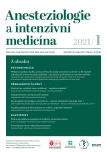Fascial planes for regional anesthesia of the lower limb
Authors:
D. Nalos
Authors‘ workplace:
Masarykova nemocnice v Ústí nad Labem
; Klinika anesteziologie, perioperační a intenzivní medicíny Univerzita J. E. Purkyně v Ústí nad Labem
Published in:
Anest. intenziv. Med., 32, 2021, č. 1, s. 36-43
Category:
Review Articles
Overview
The article is a continuation of the series on the importance of fascia for regional anesthesia. This chapter attempts to align the anatomical structure of the lower limb with the requirements for regional anesthesia. The basic structure studied are deep fascia in the thigh area – fascia lata and deep myofascial structures. Fascia lata divides the muscles of the thigh into three compartments. The thickness of the fascia late makes it impossible for the local anesthetic to penetrate into a different com partment than the one into which it was administered. The local anesthetic is spread only in the myofascial spaces of individual compartments. The anterior compartment of the thigh is supplied by the branches of n. femoralis. The medial compartment is supplied by the branches of the obturatorius nerve, and the posterior compartment is supplied by the sciatic nerve. The second part of the text is focused on a more detailed analysis of thigh areas suitable for an application of regional anesthesia.
Keywords:
fascia – ultrasound – regional anesthesia – lower limb
Sources
1. Willard FH, Vleeming A, Schuenke MD, Danneels L, Schleip R. The thoracolumbar fascia: anatomy, function and clinical considerations. J. Anat 2012; 221: 507–536.
2. Nalos D. Fasciální prostory trupu ve vztahu k regionální anestezii – část druhá: lumbální oblast. Anest intenziv Med. 2020; 31(3): 86–95.
3. Stecco C. Functional Atlas of the Human Fascial System. Edinburgh, UK, Churchilll Livingstone Elsevier, 2015; 59.
4. Vloka JD, Hadžič A, Lesser JB, Kitain E, Geatz H, April EW, et al. A Common Epineural Sheath for the Nerves in the Popliteal Fossa and Its Possible Implications for Sciatic Nerve Block Anesth Analg 1997; 84(2): 387–390.
5. Broski SM, Murthy NS, Krych AJ, Obey MR, Collins MS. The adductor magnus „mini‑hamstring“: MRI appearance and potential pitfalls. Skeletal Radiol 2016 Feb; 45(2): 213– 219. doi: 10.1007/s00256-015-2291-5.
6. Spinner RJ, Wang H, Carmichael SW, Amrami KK, Scheithauer BW. Epineurial Compartments and Their Role in Intraneural Ganglion Cyst Propagation. Clinical Anatomy 2007; 20(7): 826–833.
7. Nielsen TD, Moriggl B, Søblle K, Kolsen‑Petersen AJ, Børglum J, Bendtsen TF. Subpectineal Injectate Spread Around the Obturator Nerve and Its Hip Articular Branches. Reg Anest Pain Med 2017; 42(3): 357–361. doi: 10.1097/AAP.0000000000000587.
8. Gustafson KJ, Pinault GC, Neville JJ, Syed IS, Davis JA Jr, Jean‑Claude J, et al. Fascicular anatomy of human femoral nerve: Implications for neural prostheses using nerve cuff electrodes. J Rehabil Res Dev. 2009; 46: 973–984. PMID:20104420. http://dx.doi.org/10.1682/JRRD.2008. 08. 0097
9. Vermeylen K, Desmet M, Leunen I, Soetens F, Neyrinck A, Carens D, et al. Supra‑ inquinal injection for fascia iliaca compartment block result in more consistent spread towards the lumbar plexus than an infra‑ inguinal injection: an volunteer study. Reg Anest Pain Med 2019; 44: 483–491.
10. Goffin P, Lecoq JP, Ninane V, Brichant JF, Sala‑Blanch X, Gautier PE, et al. Interfascial Spread of Injectate After Adductor Canal Injection in Fresh Human Cadavers. Anesth Analg. 2016; 123(2): 501–503.
11. Pivec Ch, Bodner G, Mayer JA, Brugger PC, Paraszti I, Moser V, et al. Novel Demonstration of the Anterior Femoral Cutaneous Nerves using Ultrasound. Ultraschall Med 2018: Online ahead of print. https://doi.org/10.1055/s-0043-121628.
12. Burckett‑St Laurant, D, Peng, P, Arango LG, Niazi AU, Chan VWS, Agur A, et al. The nerves of the adductor canal and the innervation of the knee: an anatomic study. Regl Anesth Pain Med 2016; 41(3): 321–327. doi: 10.1097/AAP.0000000000000389.
13. Runge CH, Moriggl B, Børglum J, Bendtsen TF. The Spread of Ultrasound‑Guided Injectate From the Adductor Canal to the Genicular Branch of the Posterior Obturator Nerve and the Popliteal Plexus a Cadaveric Study. Reg Anesth Pain Med 2017; 42(6): 725–730. doi: 10.1097/AAP.0000000000000675.
14. Labat G. Regional Anesthesia: Its Technic and Clinical Application. Philadelphia, PA: Saunders, 1924.
15. Nalos D, Mach D. Periferní nervové blokády. 1. vydání Grada 2010; 100 s.
16. Grim M, Naňka O, Helekal I. Atlas anatomie člověka. díl I. Grada publishing 2017: 152 s.
17. Perlas A, Wong P, Abdallah F, Hazrati LN, Tse C, Chan V. Ultrasound‑Guided Popliteal Block Through a Common Paraneural Sheath Versus Conventional Injection A Prospective, Randomized, Double‑blind Study. Reg Anesth and Pain Med 2013; 38(3): 218–225. doi: 10.1097/AAP.0b013e31828db12f.
Labels
Anaesthesiology, Resuscitation and Inten Intensive Care MedicineArticle was published in
Anaesthesiology and Intensive Care Medicine

2021 Issue 1
Most read in this issue
- Doporučení pro anestezii a sedaci u kojících žen
-
Point of care examination of blood clotting –
current possibilities - Ketamin – nezávislost disociativní a analgetické působnosti
- Fascial planes for regional anesthesia of the lower limb
